It has been almost 3 weeks since the heavy rain and serious floods occurred in southern region of Kumamoto following other parts of Kyushu later. I have visited Hitoyoshi City and love it so much. It was very sad and heartbreaking to see innocent people who are devastated, left with destroyed house covered with mud. I don’t know how to express my feeling but my thoughts are with them and their families. What I can do is quite limited but I will keep supporting them in my own way.
So now, have you heard of this music?
This video is from 火の国祭り(Hinokuni Festival). Hinokini Festival is held on the first Friday and Saturday in August every year in Kumamoto City and it is one of the highlight of summer in Kumamoto.
The song is well known as the music for the festival and it is called as “サンバおてもやん(Samba Otemoyan)”. “Otemoyan” is a name of a local lady from Kumamoto. The last day of the festival, they make the main road in downtown car-free zone and over 5,000 people dance Samba Otemoyan. Unfortunately this year, Kumamoto City has announced that they decided to call off the festival because of the coronavirus.
Samba Otemoyan is a lightsome music and a symbol of the festival. But originally, this song is slower tempo music like this one below.
First of all, the kids are so cute, aren’t they?
Last month, I dropped by at one secondhand book store, タケシマ文庫(Takeshima Secondhand Bookstore) in Tsuboi(Chuoku Kumamoto City) and I met this book about Otemoyan.
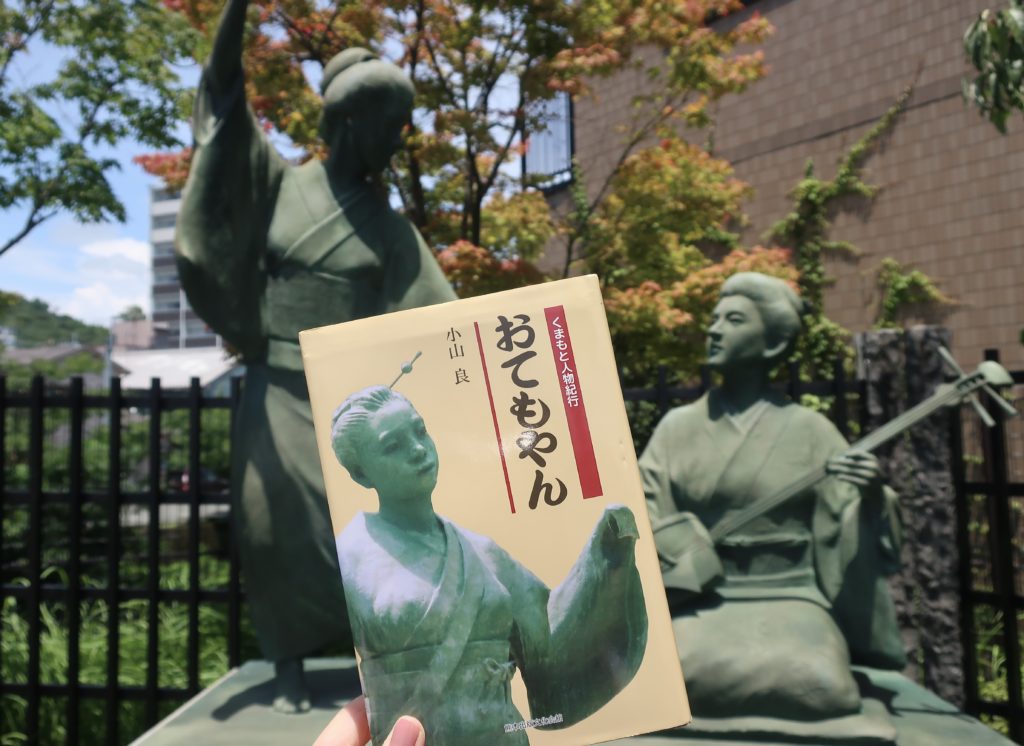
Otemoyan is believed to be a lady who was a model of the song. The character “Otemoyan” is popular in Kumamoto and there are some souvenirs and products named Otemoyan. When I saw the book, I thought I don’t know anything about Otemoyan so why not take it and get to know her. What I knew about Otemoyan was the music in Hinokuni Festival, that was all. The more I read this book, the more I got interested in the model of Otemoyan and the person who wrote the song.
I pay great respect to 小山良(Ryo Oyama) who wrote this book. I was impressed by his great passion towards the research of Otemoyan. Through reading the book, I witnessed that the passion of urging to know something moves people and discover something priceless. As I shared in the last article, when it comes to a history of common people, if we don’t pass them on to the next generation, they will be easily forgotten. Let’s talk about people who lived in our neighbor and get to know about them more.
So today, I’d like to take you to a tour about “Otemoyan”. In the next article, I will write about some places related to Otemoyan(I haven’t started anything yet so let’s see how it goes!)
Even local people in Kumamoto don’t know about Otemoyan well. Let’s get to know about Otemoyan and hopefully, you can join Hinokuni Festival and dance Samba Otemoyan next year!
Contents
- 1 Otemoyan(おてもやん)
- 1.1 How “Otemoyan(おてもやん)” is close to local people in Kumamoto?
- 1.2 Lyric of Otemoyan(おてもやん)
- 1.3 Who is Otemoyan(おてもやん) and who wrote the song Otemoyan(おてもやん)?
- 1.4 Hinokuni Festival(火の国祭り)
- 1.5 Look forward to Hinokuni Festival in 2021 and practice Otemoyan dance!
- 1.6 Map of “Otemoyan and Ine Nagata Park”
- 1.7 共有:
Otemoyan(おてもやん)
How “Otemoyan(おてもやん)” is close to local people in Kumamoto?
At first, I had no idea of Otemoyan except for Otemoyan Samba in Hinokuni Festival. One of my colleagues who is from Amakusa told me that she learned the folk song Otemoyan(not the samba one) in elementary school and she sang it to me. Surprisingly, she still remembers the song very well. She said she doesn’t know the meaning of the song well but the melody has sticked to her still now.
The song “おてもやん(Otemoyan)” got popular after 赤坂小梅(Koume Akasaka) release the record of Otemoyan in 1935. Previously, it was played only in 花柳界(Karyu-kai) means the world of 芸者(Geisha). But after Akasaka released the record, it became popular around Japan.
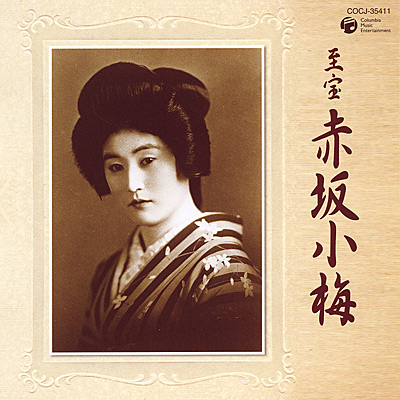
Source : https://columbia.jp/artist-info/koume/discography/COCJ-35411.html
In 2011, the rail of Kyushu Shinkansen express was connected all the way from Fukuoka to Kagoshima(previously, some parts were not connected). At that time, they adopted Otemoyan as a melody to announce at Kumamoto Station(In Japan, just before you arrive at some station, you will hear some melody announcing you are going to arrive at the station.).
Check the video below! This melody is arranged synchronizing to the origin of Otemoyan(I feel it is very different from the original Otemoyan!).
As I said earlier, Otemoyan is now popular for presenting Hinokuni Festival. On the last day of the festival, more than 60 groups and 5,000 people join and dance.
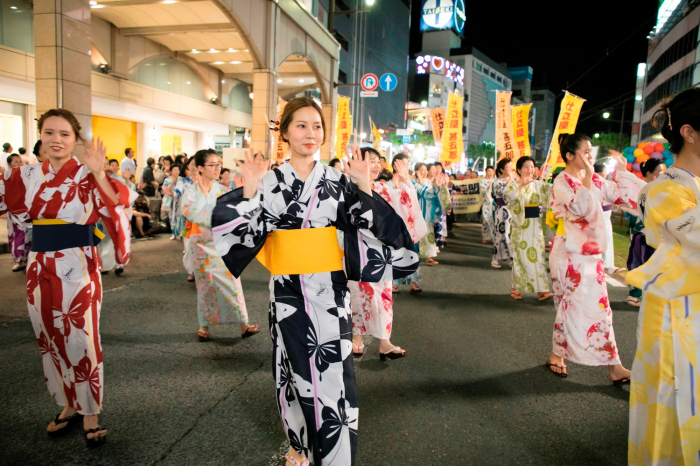
Lyric of Otemoyan(おてもやん)
Now, let’s explore the lyric of Otemoyan. Otemoyan is one of the folk songs representing Kumamoto. The lyric has a strong Kumamoto dialect and we don’t really use many expression in the song now. I tried my best to translate it in English. Listen to Otemoyan song by 赤坂小梅(Koume Akasaka) below and check the meaning.
おてもやん(Otemoyan)
1.
おてもやん あんたこの頃嫁入りしたではないかいな
(Otemoyan anta konogoro yomeiri shitadewa naikaina)
嫁入りしたこたしたばってん
(Yomeiri shitakota shitabatten)
ご亭どんがぐしゃっぺだるけん、まぁだ盃はせんだった
(Goteidon ga gushappedaruken mada sakaduki wa sendatta)
村役 鳶役 肝煎りどん あん人たちのおらすけんで
(Murayaku tobiyaku kimoiridon anhitotachi no orasukende)
あとはどうなっときゃあなろたい
(Ato ha dounatto kyaanarotai)
川端町っつぁん きゃぁめぐろ
(Kawabatamachi tsuan kyaa meguro)
春日ぼうぶらどんたちゃ 尻ひっぴゃぁて花盛り花盛り
(Kasuga boubura dontacha shiri hippyaate hanazakari hanazakari)
ピーチクパーチク雲雀の子 げんばく茄子のいがいがどん
(pi-chiku pa-chiku hibari no ko genbakunasu no igaigadon)
A person : Otemoyan, I heard you have recently got married.
Otemoyan : Yes, I have but I haven’t met the groom. I heard that he has smallpox so we haven’t had the wedding ceremony yet. Anyway, I guess someone will take care of it. By the way, let’s explore around 川端町(Kawabata Town, now it’s Chuo-ku Kumamoto City). A lot of men looking like 春日ぼうぶら(Kasuga Bobura pumpkin) have been following me. I am very popular with guys and my life is at the best. There are some guys walking on the air and singing like ひばり(skylark bird). There are another unsophisticated guys looking like げんばく茄子(Genbaku Nasu eggplant). They all are not my type.
2.
一つ山越え も一つ山越え あの山越えて
(Hitotsu yama koe mohitotsu yama koe ano yama koete)
私しゃあんたに惚れとるばい
(Watasha anta ni horetoru bai)
惚れとるばってん言われんたい
(Horetoru batten iwaren tai)
追々彼岸も近まれば 若者衆も寄らすけん
(Oioi higan mo chikamareba wakamonshu no yorasuken)
くまんどんのよじょもん詣りにゆるゆる話しもきゃぁしゅぅた
い(Kumandon no yojomon mairi ni yuruyuru hanashi mo kyaashuutai)
男振りには惚れんばな(Otokoburi niwa horenbana)
煙草入れの銀金具が それがそもそも因縁たい
(Tabacco ire no ginkanagu ga sore ga somosomo innen tai)
アカチャカ ベッチャカ チャカチャカ チャー
(akachaka becchaka chakachaka cha-)
Otemoyan : I am in love with one man living in a place over mountains.
But as a woman, I can’t tell him that I am in love with him.
Soon, there will be お彼岸(Ohigan, during the time, we go and visit the family cemetery) and there will be many young people gathering at the temple and listening to sermon. He will also come so I may be able to talk to him. I don’t mean that I like him because of his looks. I just liked his silver tobacco case.
3.
一つ世の中 艱難辛苦の荒波越えて
(Hitotsu yononaka kannanshinku no aranami koete)
男度胸でおいでなさい
(Otoko dokyo de oidenasai)
くよくよしたとてしょうがない
(Kuyokuyo shitatote shoganai)
何時か目も出る花も咲く
(Itsuka ha me no deru hana mo saku)
移り気な浮き世のならいに 取り越し苦労はおやめなさい
(Utsurigi na ukiyo no narai ni torikoshi kurou wa oyamenasai)
悩みなんぞはこちゃ知らぬ
(Nayami nanzo wa kocha shiranu)
意地と張りの心が それが後生楽たい
(Iji to hari no kokoro ga sore ga koshoraku tai)
アカチャカ ベッチャカ チャカチャカ チャー
(Akachaka becchaka chakachaka cha-)
Otemoyan : There are many things happening in our lives but men should always be strong and brave. Women should be, too. Do not think twice. If you work hard, it will be paid off. Things will always change so do not worry about future too much. I do not have worries now. Have a strong will that you will achieve. Then, the life will be much easier.
Did you enjoy the world of Otemoyan? I am originally from Oita Prefecture and for me it is very difficult to understand original lyric in Kumamoto dialect(especially, the first verse). It is said that the song Otemoyan was written in 1900. At that time, “Otemoyan” had only 1st and 2nd verses. Then in the beginning of 20th century, it is said that the composer added the third verse and accomplished it.
Who is Otemoyan(おてもやん) and who wrote the song Otemoyan(おてもやん)?
Now, you may wonder who is Otemoyan and what was she like?
When the song came out, people were very curious who was the model. The composer never told about the model but after she died, one man spoke to the television that his grandmother was the model of Otemoyan. Still now, there are many mysteries about Otemoyan but it makes Otemoyan more attractive
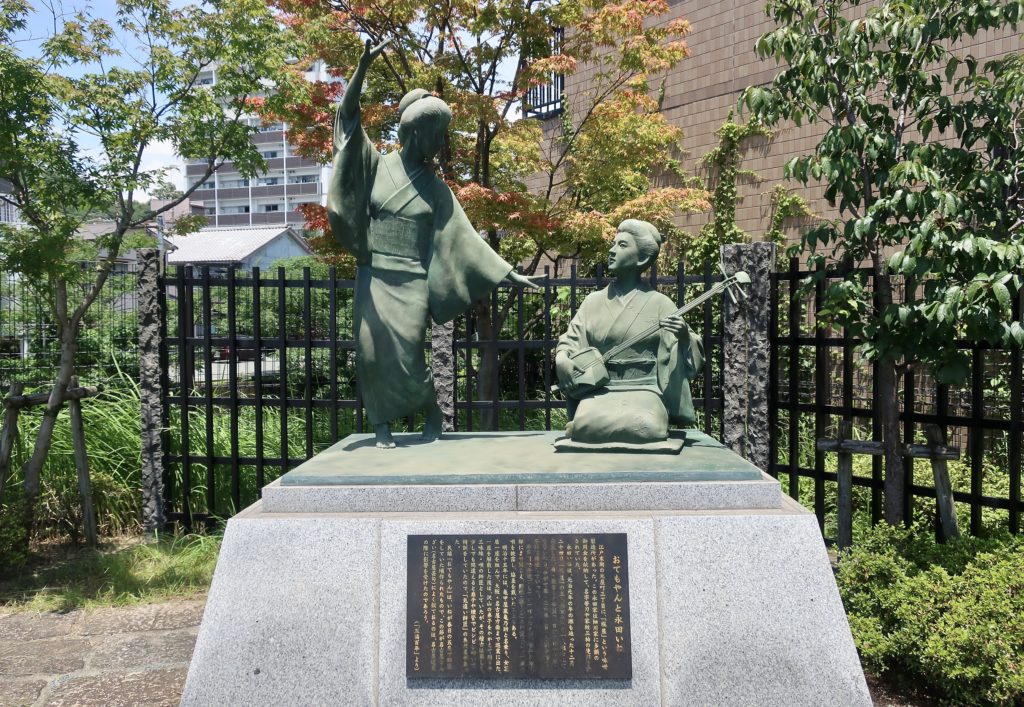
The composer, 永田稲(Ine Nagata), Professional Geisha who had been independent and survived through the change in the time period
The composer of Otemoyan is 永田稲(Ine Nagata) who was from 米屋町(Komeya-machi, it’s now Chuo-ku, Kumamoto City). She was born in 1865. This area had flourished as 城下町(Jokamachi, a castle town) and there were many craftsmen. Now, this area has many tall buildings, such as apartments and hotels.
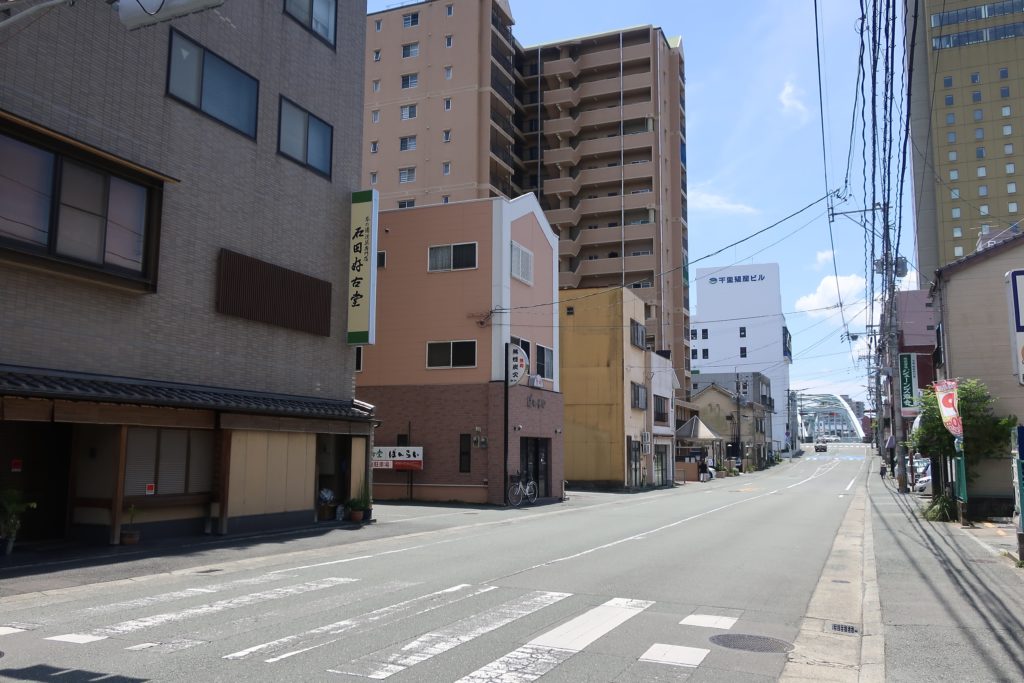
Nagata Family owned a factory called “糀屋(Momoya)” and they had made 醤油(Shoyu, soy sauce) and 味噌(Miso, Miso paste).

They had a strong connection with Hosokawa Family who ruled Kumamoto at that time. Nagata Family had donated a lot to Hosokawa Family and they were considered to be high position family who was allowed to have family name, family crest and Japanese swords at that time, only limited families were allowed to have these.).
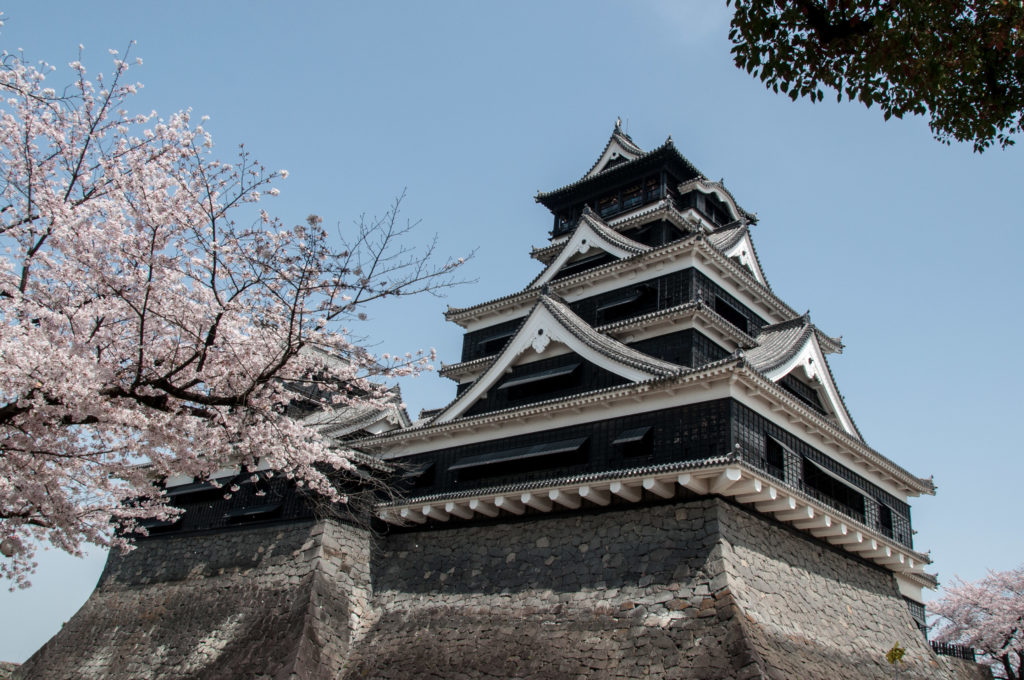
Source : キロクマ!
But always the world is changing and prosperity will come to an end. Momoya used to sell their products only regular customers, such as Hosokawa Family and other high-social position customers. Because of that, their business were good and stable. After Meiji period(the end of 19th century), the political system changed completely and these shops with privileges were instantly thrown to open to common people. Previously, they didn’t need work hard because they had regular customers but then they had to find new customers by themselves. They tried many things to attract local customers but it was not easy at all.
Ine’s mother somehow felt that it would happen. When Ine was 4 years old, she let her daughter enter the world of performing arts and learn 琴(Koto, Japanese herp), 三味線(Shamisen, Japanese guitar), 太鼓(Taiko, drum), 唄(Uta, singing), 舞踏(Butou, dancing), 歌舞伎(Kabuki, Kabuki play), etc. Ine’s mother wanted her daughter to get skills so that she could live independently. Ine had a nature talent and got these skills pretty quickly.
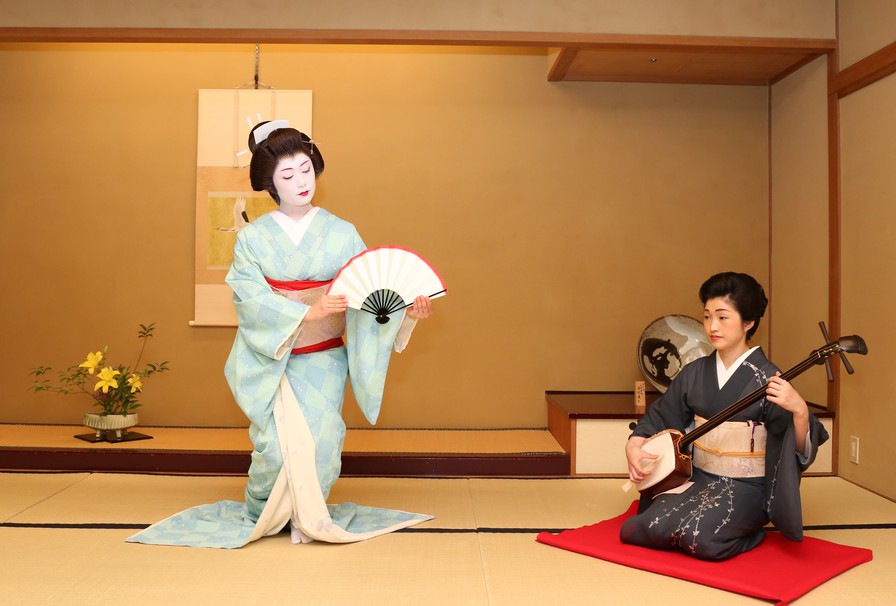
Source : HOTEL CHINZANSO TOKYO
During this period, her parent’s shop Momoya went bankrupt and they lost their house and property. The family became separated.
At the age of 18, Ine succeeded her master’s name “亀甲屋嵐亀之助” as her stage name(I am not sure how to read it but I guess it would be “Kamekouya Arashi Kamenosuke”) and she debuted as a professional Geisha. It is said that around 1895, Ine took along some Geisha and went tours to Osaka and Nagoya.
After Ine came back to Kumamoto, she witnessed a strike going on by 娼妓(Shogi, courtesan). At that time, being a courtesan was believed to be the end of the world because they didn’t have any human rights and being treated very badly. These courtesans were also in a huge debt to their employer so they couldn’t escape from them for the rest of their lives.
In 1900, courtesans saw a gleam of hope. Supreme Court delivered a verdict that employers can not bind courtesans and courtesan can stop working regardless of whether they are in debt or not. This verdict was such a breakthrough at that time to protect human rights. After that, starting from Nagoya, strikes happened around Japan by courtesans to ask for the improvements for their labor conditions. Also in Kumamoto, there were some strikes and employers accepted courtesans’ offers. At that time, Ine was 35 years old.
The lyric of the third verse is like a life lesson. It is said that this verse was written later in her life. Ine was very skilled, intellectual and well-known as a professional Geisha(Geisha and Shogi(courtesan) are different). Some pupils later told that Ine was such a strict teacher(some said Ine was “madly” strict to her pupils!).
Through her life, she realized that nothing is certain. She witnessed her parents’ business went bankrupt and how women in weak status had no choice but to work long hours in bad conditions. Seeing these hard and unfair situation, she had always tried her best to get skill to be independent.
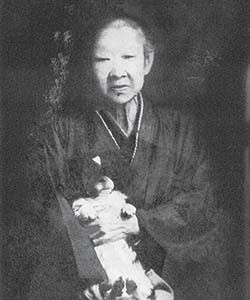
Source : https://kumamoto.tabimook.com/greate/detail/25
Later in her life, Ine stayed one of her pupils house and passed away in 1938. She was 74 years old.
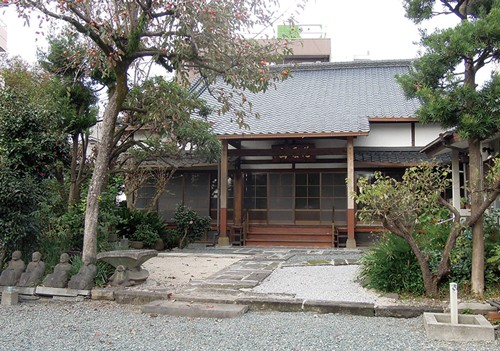
Source : https://kumamoto.tabimook.com/tourism/detail/46
At 泰巌寺(Taiganji Temple) in 下通(Shimotori, Chuoku Kumamoto City), there is a grave of Ine. Interestingly, her grave has a 扇(Ogi, means folding fan which is used in traditional Japanese dance) on top, which is very unique. And on the front side of the grave stone, you can see her stage name.
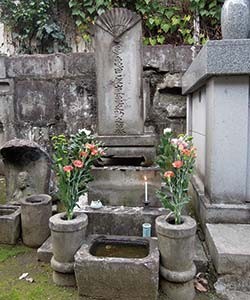
Source : https://kumamoto.tabimook.com/greate/detail/25
That is very unique because people usually put their name at the front. It is said that when Ine passed away, her pupil found 200 yen below her pillow(at present rate, it will be about 100,000 yen) . Ine didn’t want to bother anyone after her death so she prepared the money for funeral and grave for herself. Ine’s pupils built the grave with the folding fan and her stage name at the front. This shows how Ine was loved and respected by their pupils. Until the very end, Ine was an independent woman.
Tomo Tominaga(富永登茂), the model of Otemoyan(おてもやん)
Now, let’s explore a model of Otemoyan.
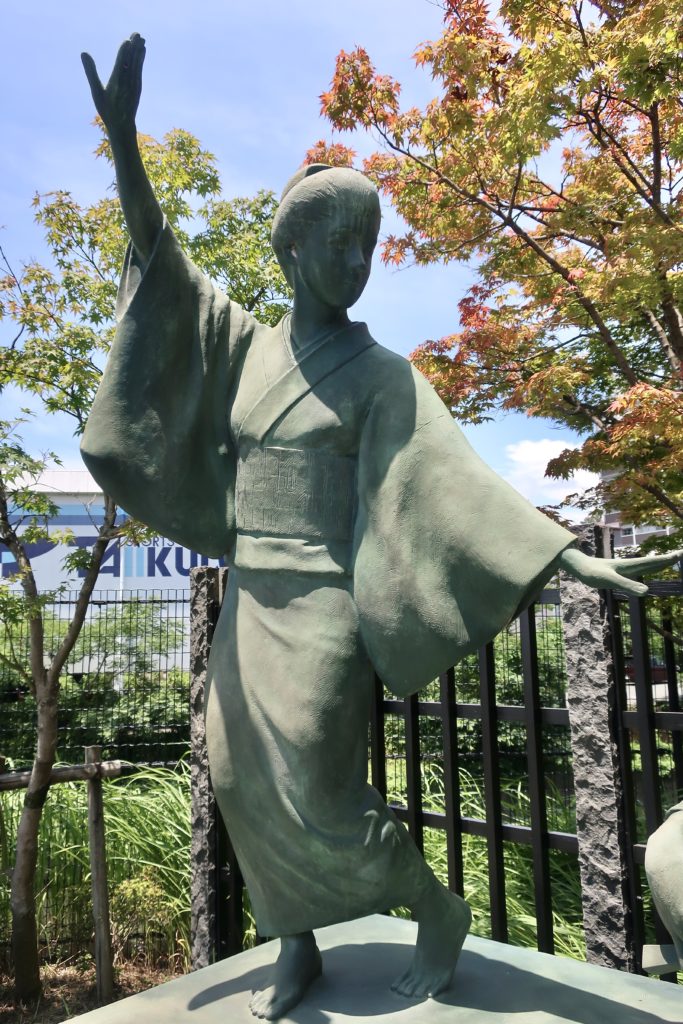
It is said that the model of Otemoyan is 富永登茂(Tomo Tominaga). Tomo was born in 横手町北岡(Yokote-machi Kitaoka) which is now 春日(Kasuga, Nishi-ku Kumamoto City). Now, Kumamoto Station stands in the area. She was born in 1855 so she was 10 years older than Ine. Tomo’s father was a peasant and the family was very poor. She had a younger sister トジュ(Toju) and they were always together. After their parents passed away(I don’t know when they died but from some documents, we can see when the sisters were 18 and 11 years old, they didn’t have parents.)
⬆️ The map of 春日(Kasuga) in Nishi-ku, Kumamoto City.
In 1880, 花街(Hanamachi Town) was open in the area called, 二本木(Nihongi, it is near Kumamoto Station). Hanamachi is a small area with fancy restaurants where you can enjoy playing with Geisha. People enjoyed the best entertainment, dance, song, etc. It must have cost a lot to go there but some became Geisha’s patrons and they supported them for a long time until they will become professional.
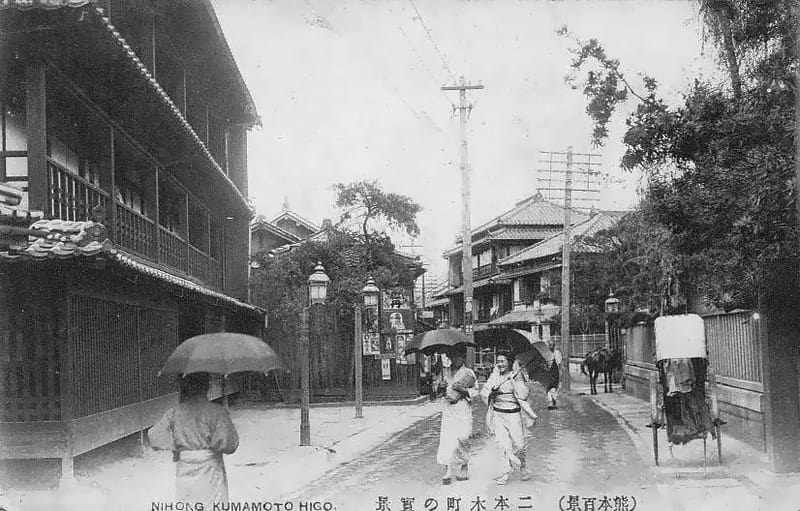
Source : https://blog.goo.ne.jp/np4626/e/4089bfbef98ba4f814ad5024b14d51c9
It is believed that Tomo used to work at one of the high-class restaurants as a servant.
In 1891, Kumamoto Station opened(at that time, it was called 春日駅(Kasuga Station) because of the area, called Kasuga). Before it was built, people were forced to move for urban development. Tomo was working at Hanamachi so she wanted to move near to it because their work finished very late.
At that time, Ine already debuted and had some pupils. Ine moved to near the station because she sometimes go for a tour and it was convenient to live near the station. It is believed that Ine and Tomo had met at that time. Ine had her own school near the station and Tomo went work near to it. It didn’t take long for them to become friends. It sounds like just a guess but there is one evidence that they were close.
Ine had kept wooden plates, called 氏子札(Ujiko-fuda). In 1871, the new Meiji Government enacted a law of Family Registration. They demanded people to go to the nearest shrine and get a Ujiko-fuda plate to prove their identification.
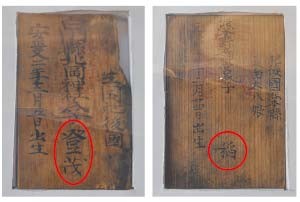
Source : https://kumamoto.tabimook.com/greate/detail/25
When Ine passed away, her pupils found Ine’s Ujiko-fuda plate and other two plates. These two turned out to be Tomo’s and Toju’s(Tomo’s sister). It seems like Ine and Tomo were close and when Tomo passed away, Ine took them over and had kept them with her.
Why 登茂(Tomo) is called “Otemoyan”?
So, why “Tomo” was called “Otemoyan”? In Japanese, Otemoyan is written like this.
お(o) て(te) も(mo) や(ya) ん(n)
We can divide it into three parts, “お(o)”, “ても(temo)”, “やん(yan)”. Let’s see them one by one.
First, let’s see “ても(temo)”. The model is believed to be 富永登茂(Tomo Tominaga). Her name “Tomo” was pronounced “Temo” with Kumamoto accent in the past.
Second, what is “お(o)”? At that time, women were called with “お(o)” on the top of their names with respect, like おふね(Ofune).(Do you know “Sazae-san”? Ofune-san is Sazae-san’s mother.)
Lastly, “やん(yan)”. Back then, people were clearly classified into one certain social position. Even in common people, there were three positions, higher, middle and lower. Common people in higher position were called with “さん(san)” at the end of their name, like Sazae-san. Middle class common people were called with “ちゃん(chan)” or “しゃん(shan)”, like Wakame-chan. And the lower class common people were called with “やん(yan)” in the end, like Otemo-yan. Because Tomo was born in poor family, they were classified into lower common people. Of course, now we do not use “yan” because it is a discrimination term but at the time, people didn’t take it like that and they just called each other with friendliness.
It is interesting to unravel the origin of the name. We can learn many things from it!
Hinokuni Festival(火の国祭り)
Now, we have learned about Otemoyan so hopefully you feel closer to her. Here, let’s get to know about 火の国祭り(Hinokuni Festival).

Kumamoto is often called as “火の国(Hi no kuni, means Country of Fire)”. Some say it came from Japanese mythology and others say it is because of the heat of summer in Kumamoto(It is very hot and humid!!).
Since 1978, we have Hinokuni festival every year on the first Friday and Saturday in August. On the first day, there are many stage events at Kumamoto Castle. During the festival, you can see many food stalls along the main roads.

On the second day, there will be the main event, おてもやん総踊り(Otemoyan Dance) on the main streets downtown. Over 60 groups and 5,000 people join and dance Otemoyan and Samba Otemoyan. Unfortunately this year, Hinokuni Festival was called off because of the effect by coronavirus.
I found one Youtube video for practicing for both Otemoyan and Samba Otemoyan. Hopefully, we can dance together in 2021! Check the video below and get the move!
Look forward to Hinokuni Festival in 2021 and practice Otemoyan dance!
When I took this book about Otemoyan, I didn’t expect to meet these lovely people, Tomo and Ine. They would have never imagined that we are talking about them now in 2020!
It was a very interesting exploration for me to reveal local characters in the past. In the next article, I am thinking to visit some places related to Temo and Ine so look forward to it!
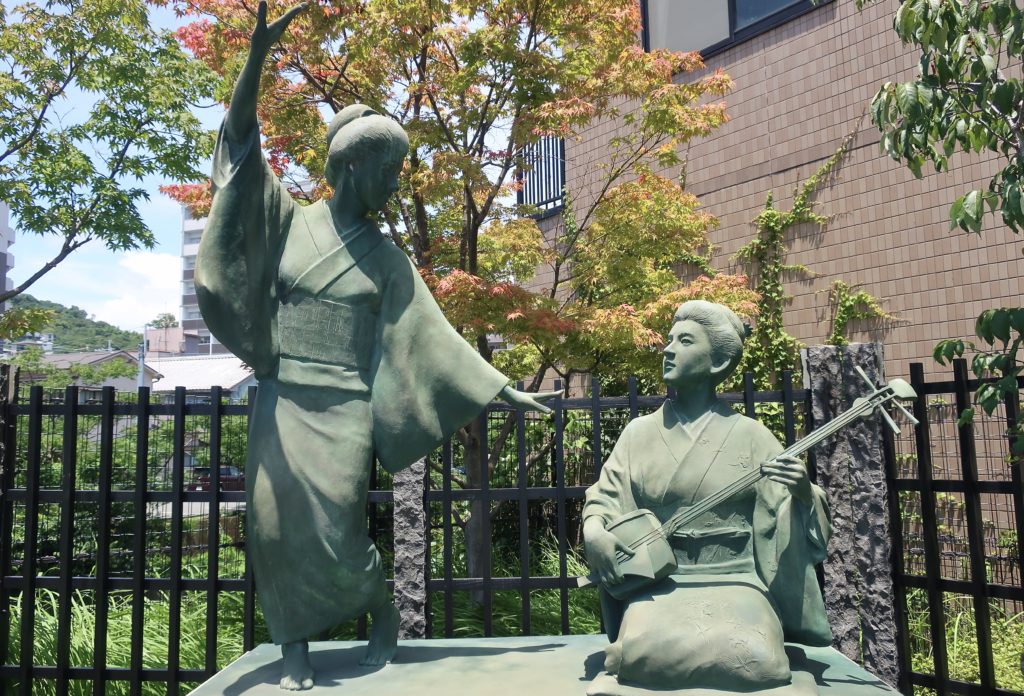
Map of “Otemoyan and Ine Nagata Park”
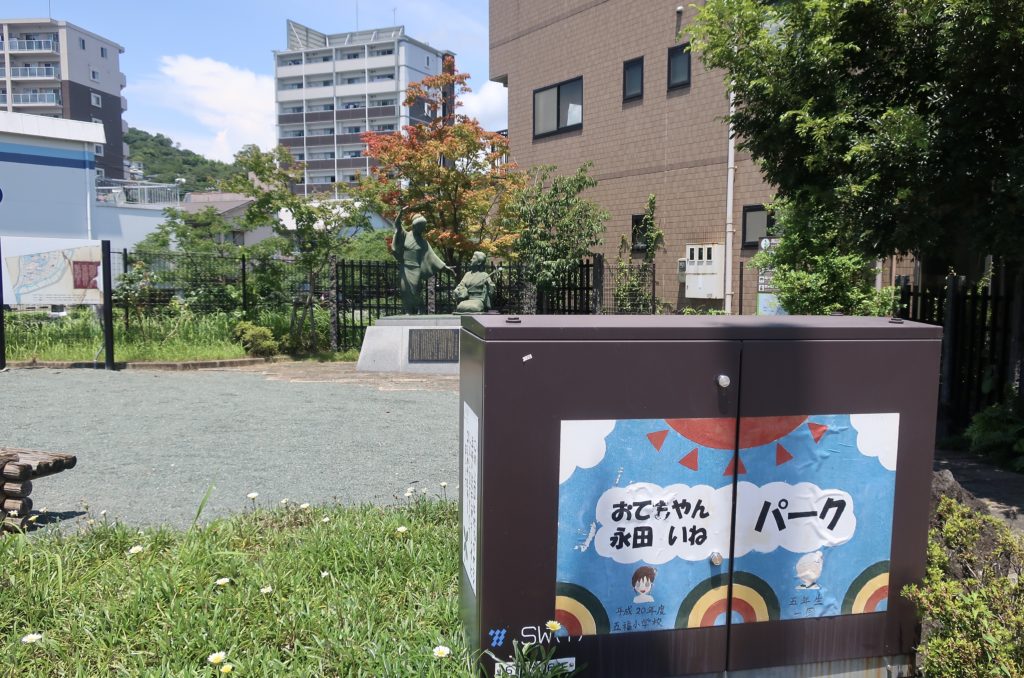
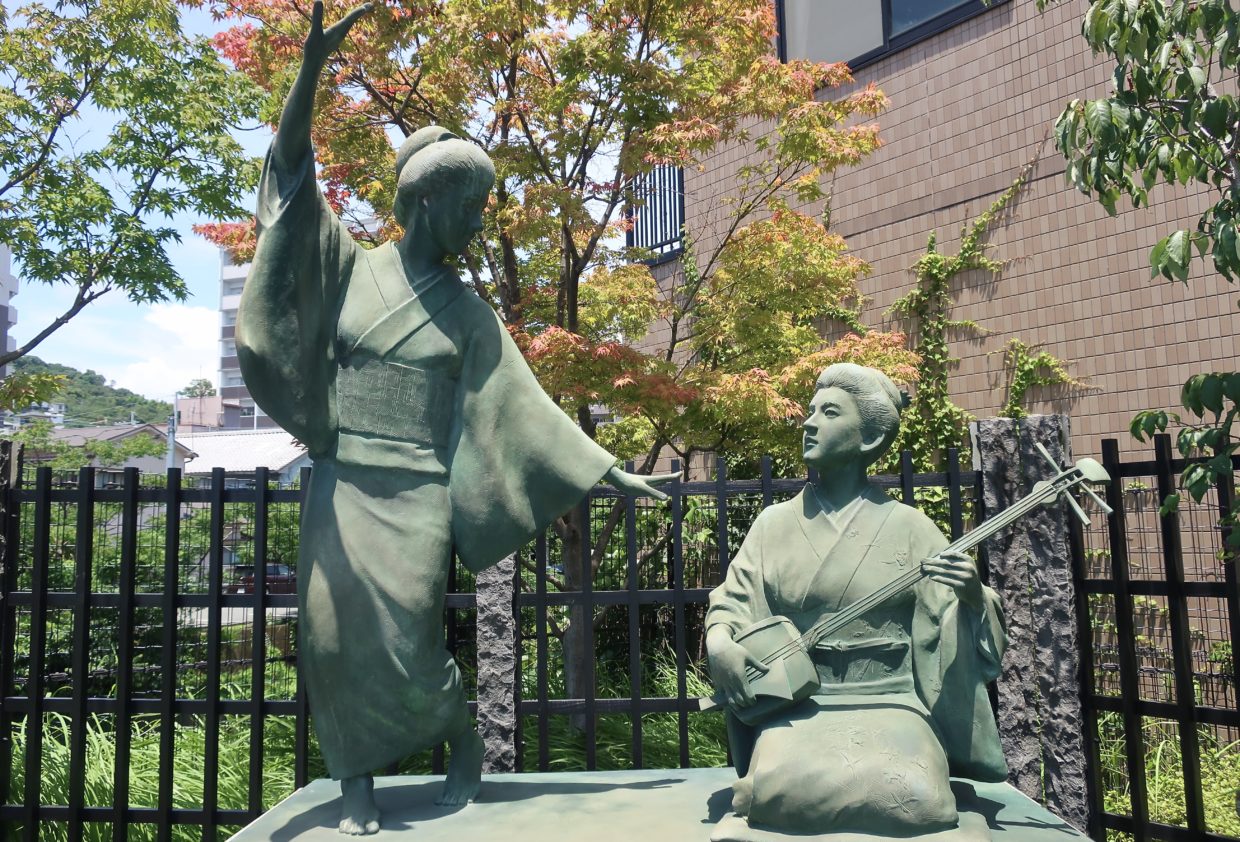
3 ピンバック